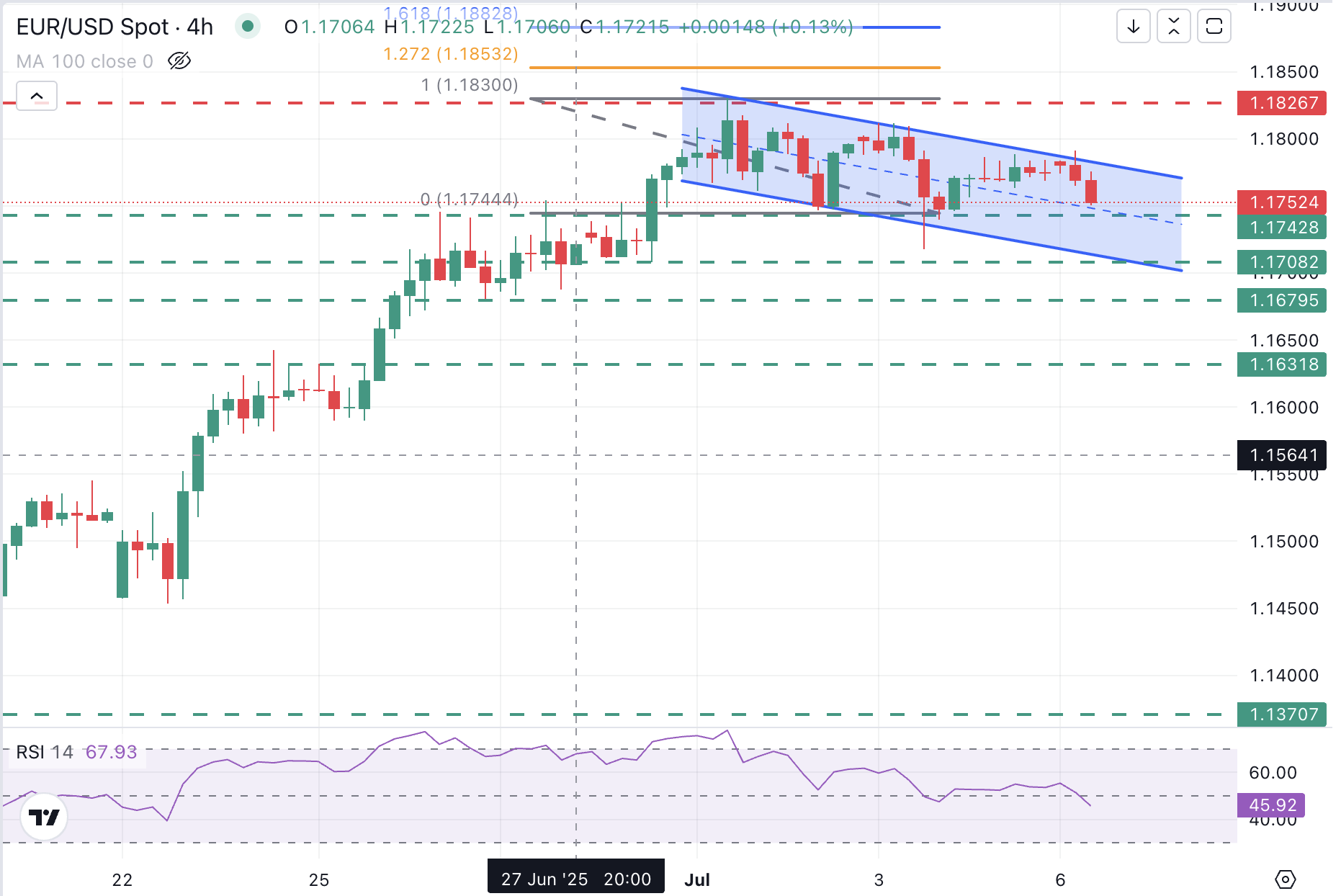Created
: 2025.07.07














![]() 2025.07.07 16:47
2025.07.07 16:47
The EUR/USD pair is accelerating its reversal on Monday, yet still trading within last week's range. The US Dollar is failing to put a significant distance from long-term lows, as the enthusiasm about the strong US employment and services data seen last week has turned to caution with the deadline for US trade tariffs on July 9 approaching.
The Euro (EUR) retreated from levels right below 1.1800 earlier on Monday and is trading at the mid-range of the 1.1700s, at 1.1755 at the time of writing, with technical indicators showing an increasing bearish momentum.
US President Donald Trump is expected to start sending letters to trade partners on Monday, informing them about the levies applied to their products. The deadline to introduce those tariffs is on Wednesday, but comments from Treasury Secretary Scott Bessent suggesting that the levies will be applied from August 1 have added uncertainty to the issue, which is keeping investors on edge.
Nearly three months after Trump announced a moratorium on tariffs, only three countries have closed trade deals with the US: China, the UK, and Vietnam. In China's case, the deal was more based on a de-escalation of previously imposed levies rather than a proper trade agreement.
The US administration, however, keeps touting upcoming deals in the coming days. Market sources suggest that India might be close to a mini deal, and Bessent mentioned progress with the European Union.
Looking at the economic calendar, German Industrial Production beat expectations with an unexpected return to growth in May. Later today, the Eurozone Retail Sales data and the Sentix Investors' Confidence Index will give further insight into the momentum of the Eurozone economy. The market is likely to be more sensitive to negative data amid the risk-off sentiment triggered by renewed uncertainty about global trade.
The table below shows the percentage change of Euro (EUR) against listed major currencies today. Euro was the strongest against the Australian Dollar.
| USD | EUR | GBP | JPY | CAD | AUD | NZD | CHF | |
|---|---|---|---|---|---|---|---|---|
| USD | 0.13% | 0.26% | 0.65% | 0.30% | 0.82% | 0.83% | 0.18% | |
| EUR | -0.13% | 0.14% | 0.27% | 0.15% | 0.75% | 0.69% | 0.03% | |
| GBP | -0.26% | -0.14% | 0.12% | 0.03% | 0.62% | 0.56% | -0.23% | |
| JPY | -0.65% | -0.27% | -0.12% | -0.11% | 0.39% | 0.41% | -0.41% | |
| CAD | -0.30% | -0.15% | -0.03% | 0.11% | 0.53% | 0.53% | -0.26% | |
| AUD | -0.82% | -0.75% | -0.62% | -0.39% | -0.53% | 0.05% | -0.84% | |
| NZD | -0.83% | -0.69% | -0.56% | -0.41% | -0.53% | -0.05% | -0.79% | |
| CHF | -0.18% | -0.03% | 0.23% | 0.41% | 0.26% | 0.84% | 0.79% |
The heat map shows percentage changes of major currencies against each other. The base currency is picked from the left column, while the quote currency is picked from the top row. For example, if you pick the Euro from the left column and move along the horizontal line to the US Dollar, the percentage change displayed in the box will represent EUR (base)/USD (quote).

EUR/USD is on a bearish correction from last week's highs at 1.1830. Technical indications show a growing bearish momentum, as the 4-hour Relative Strength Index (RSI 14) swung into negative territory, at levels below 50, and price action approaches the July 2 low at 1.1740.
Below here, there is scope for a bearish extension to retest the bottom of the descending channel from the mentioned July 1 high, now at 1.1715, which is close to the June 30 low, at 1.1710. Next support is the area between the June 26 and 27 lows at 1.1680-1.1685.
On the upside, the pair should breach the channel top at 1.1785 and the intra-day high at 1.1790 to challenge the immediate bearish trend. That would set its focus on the 1.1815-1.1825 resistance area, which held bulls on July 1, 2, and 3.
Tariffs are customs duties levied on certain merchandise imports or a category of products. Tariffs are designed to help local producers and manufacturers be more competitive in the market by providing a price advantage over similar goods that can be imported. Tariffs are widely used as tools of protectionism, along with trade barriers and import quotas.
Although tariffs and taxes both generate government revenue to fund public goods and services, they have several distinctions. Tariffs are prepaid at the port of entry, while taxes are paid at the time of purchase. Taxes are imposed on individual taxpayers and businesses, while tariffs are paid by importers.
There are two schools of thought among economists regarding the usage of tariffs. While some argue that tariffs are necessary to protect domestic industries and address trade imbalances, others see them as a harmful tool that could potentially drive prices higher over the long term and lead to a damaging trade war by encouraging tit-for-tat tariffs.
During the run-up to the presidential election in November 2024, Donald Trump made it clear that he intends to use tariffs to support the US economy and American producers. In 2024, Mexico, China and Canada accounted for 42% of total US imports. In this period, Mexico stood out as the top exporter with $466.6 billion, according to the US Census Bureau. Hence, Trump wants to focus on these three nations when imposing tariffs. He also plans to use the revenue generated through tariffs to lower personal income taxes.
![]()
Created
: 2025.07.07
![]()
Last updated
: 2025.07.07

FXStreet is a forex information website, delivering market analysis and news articles 24/7.
It features a number of articles contributed by well-known analysts, in addition to the ones by its editorial team.
Founded in 2000 by Francesc Riverola, a Spanish economist, it has grown to become a world-renowned information website.
We hope you find this article useful. Any comments or suggestions will be greatly appreciated.
We are also looking for writers with extensive experience in forex and crypto to join us.
please contact us at [email protected].
Disclaimer:
All information and content provided on this website is provided for informational purposes only and is not intended to solicit any investment. Although all efforts are made in order to ensure that the information is correct, no guarantee is provided for the accuracy of any content on this website. Any decision made shall be the responsibility of the investor and Myforex does not take any responsibility whatsoever regarding the use of any information provided herein.
The content provided on this website belongs to Myforex and, where stated, the relevant licensors. All rights are reserved by Myforex and the relevant licensors, and no content of this website, whether in full or in part, shall be copied or displayed elsewhere without the explicit written permission of the relevant copyright holder. If you wish to use any part of the content provided on this website, please ensure that you contact Myforex.
Myforex uses cookies to improve the convenience and functionality of this website. This website may include cookies not only by us but also by third parties (advertisers, log analysts, etc.) for the purpose of tracking the activities of users. Cookie policy